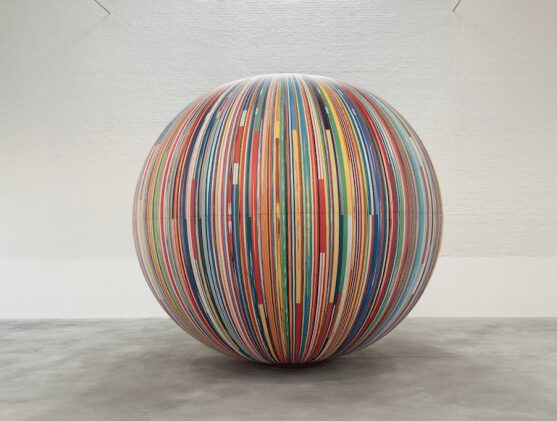Manège de Sury, Mons, Belgium
13 Jun 2015 - 18 Oct 2015

Meschac Gaba, Glo-Balloon, 2013. Photo: Philippe De Gobert
This contemporary art exhibition, organized by WIELS in collaboration with Mons 2015—European Capital of Culture, presents a group of artists interested in phenomena of circulation, diaspora and cultural dislocation.
The title alludes to the ideas of Edouard Glissant, the influential thinker of hybridisation and globalisation, who argues in favour of fluid identities, unhindered exchanges and an ideal cosmopolitan openness, which he calls the “Relation,” interconnected and radically egalitarian.
Mons and the Borinage, once a historic epicentre of the early industrialisation on the continent—a cultural and social carrier synonym of modernity—was the hub of important work-related migrations, toward a “better” life, as well as the symbol of cultural and social intermix. Plural identities and similar subjects related to globalisation had a pioneering destiny in the region, which subsequently saw the emergence of multiple models of social utopia.
Touching upon notions of otherness and difference in the eye of globalisation, the exhibition also explores the specificity of a place and its history: the Manège de Sury—an ancient Civil Guard barrack—and an old convent-school, both formerly housed a kind of “micro-city” or ideal community. The refurbished architectural complex will, in 2016, become a start-up incubator, and urban archipelago destined to serve a creative and technological future, fuelled by the free exchange of information and data.
Twenty-three artists have installed a proposal for an atopolis, or a proposal for an ideal city, connected to everyplace, or anyplace. Amongst the new productions by Saâdane Afif, Nevin Alada?, Danai Anesiadou, El Anatsui, Kapwani Kiwanga, David Medalla, Vincent Meessen, Walter Swennen, Lawrence Weiner and Jack Whitten, there are unseen monographic presentations by Yto Barrada, Vincen Beeckman, Benoit Platéus, and Thomas Hirschhorn. Also featured are works by Francis Alÿs, Walead Beshty, Huma Bhabha, Vlassis Caniaris, Abraham Cruzvillegas, Meschac Gaba, Jef Geys, Adrian Melis, and Diego Tonus.
The performative works such as Afif’s speaker’s corner in the streets of Mons, or Alada?’s Music Room, are regularly activated from June to October. Hirschhorn’s “studio” invites the audience to research, learn and participate. The complementary program offers meetings with certain artists, guided visits with the curators, workshops for children, as well as screenings.
A co-production of the Mons 2015 Foundation, the Museums of Mons and WIELS, with the generous support of IDEA, Groupe IMBC, Sowalfin, Ores, and La société Wallonne des eaux, as well as the support of Pro Helvetia and the Mexican Embassy in Belgium.
Artists: Saâdane Afif, Nevin Alada?, Francis Alÿs, El Anatsui, Danai Anesiadou, Yto Barrada, Walead Beshty, Huma Bhabha, Vincen Beeckman, Vlassis Caniaris, Abraham Cruzvillegas, Meschac Gaba, Jef Geys, Thomas Hirschhorn, Kapwani Kiwanga, David Medalla, Vincent Meessen, Adrian Melis, Benoit Platéus, Walter Swennen, Diego Tonus, Lawrence Weiner and Jack Whitten
Curator: Dirk Snauwaert
Co-Curator: Charlotte Friling
Publication
A book edited and published by (SIC), with graphic design by Joël Vermot-Harrisson, accompanies the exhibition. The catalogue is designed around two interdependent axes.
The first axis revolves around commissioning four authors from different fields (Jan Baetens, Yves Citton, Yoann Van Parys, Elvan Zabunyan) not to write theoretical or historical essays addressing the issues raised in the exhibition, but rather to write short texts about all of the artists in relation to the exhibited works, resulting in a total of around twenty texts, describing each work from every author’s unique point of view (ranging from literature to the history of ideas to art and cultural history). The second axis is conceived like a compass, allowing for different anchor points stemming from different historical milestones, once again coming from different fields, on one hand echoing the question of utopias, and on the other, to the question of technology and information dissemination techniques.
Manège de Sury
Rue des Droits de l’Homme 2
7000 Mons,
Belgium